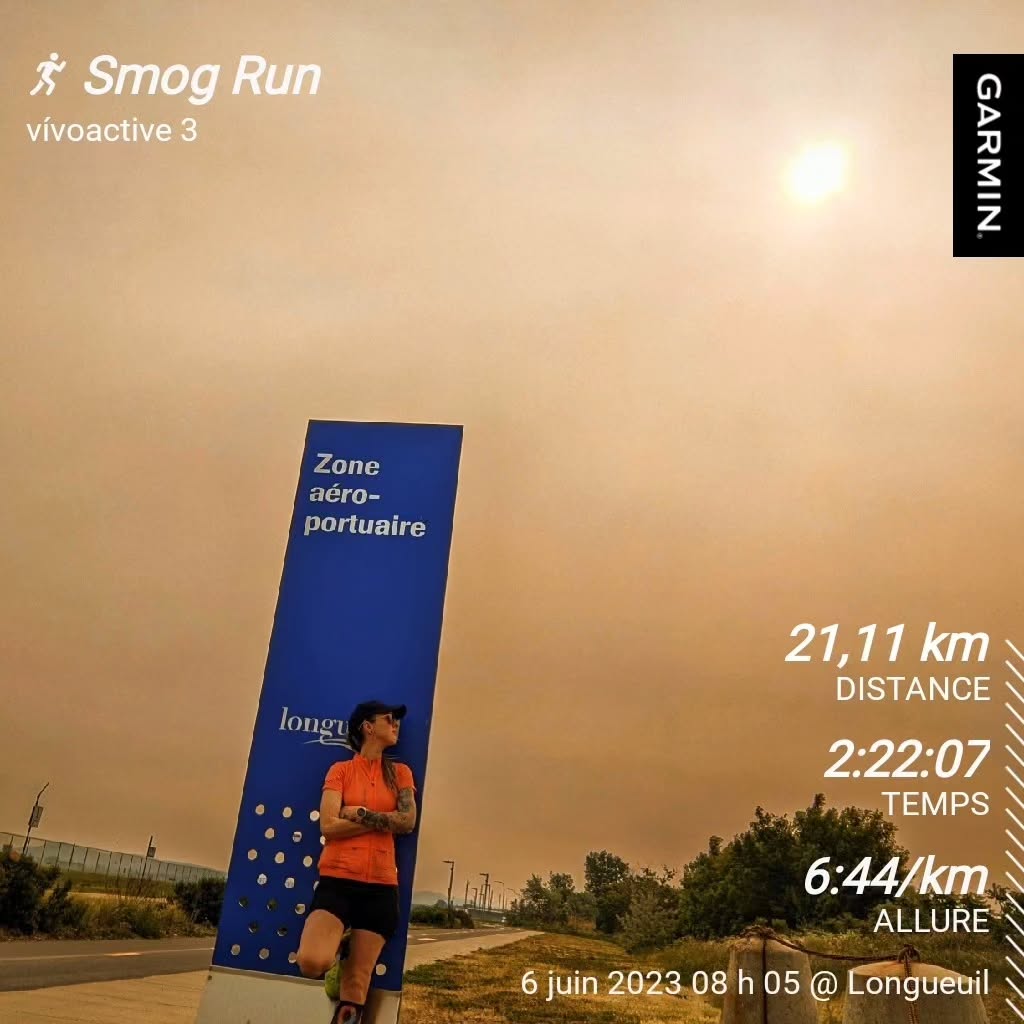Unfortunately the number of days that poor air quality is effecting us each year has gone up with more wildfires or in some cases more pollution. It’s critical to understand just how much the AQI can impact you as a runner, not just that run, but afterwards as well.

Can I run in the smoky air? How are you dealing with running in smog? What are my options for running in bad air quality?
These questions are filling my inbox more and more each year as wildfires are spreading and the season is extending.
In Colorado, I spent much of last summer looking at the brown sky and obscured mountains due to bad air quality from wildfires. Some days you could step outside and smell the smoke, but others it was more just seeing that brown from a distance.
Let’s talk about the Air Quality Index and give you a better picture of how does it take bad air quality to effect you.
What AQI Can I Not Run In?
In theory anything under 150 is going to be ok for the majority of runners who don’t have asthma or other health issues that can impact breathing. At least that’s the story that we’ve been telling ourselves.
A study in Sports Medicine found an association between poor air quality and slower marathon finishing times. These numbers were UNDER the standard recommendations, which tell us that air quality has a bigger impact than many previously realized.
In 2018, race directors made the call to cancel the North Face Endurance Challenge 50 Miler due to poor air quality from nearby wildfires. With an Air Quality Index (AQI) of 200, considered “very unhealthy,” they made the right call. It’s time to start thinking of Air Quality like you would running in heat and humidity.
It’s going to impact your performance, but unlike heat your body doesn’t have tools to combat this new obstacle.
Unfortunately many of us WANT TO RUN, so we ignore the cancellation of races or the warnings. We head out any ways feeling like surely one run won’t matter or we haven’t “noticed” any issues, so it’s ok. Or of course runners are tough and run through anything. But this is skewed thinking, let’s talk more about why.

When is it bad to exercise outside is a question that many people are juggling daily when trying to train and understand just how much the air outside is going to hurt performance and health.
Another 2023 study followed a group of college athletes training in poor air quality leading up to a 5K race and found they indeed had slower finishing times!
Thus being out in this air all the time is going to impact total performance. But this isn’t just about wildfires, it’s about running next to busy roads as well.
- runners in China with some of the worst air quality
- smog in LA or inversions in Salt Lake that increase with summer heat
- poor air quality can exist just from running next to a busy road
- wildfire smoke
- even dust, pollen, etc can impact air quality
You may not remember, but in 2008 Haile Gebrselassie opted out of the Beijing Olympics due to the air quality because he is a runner who also suffers from asthma attacks.
Understanding AQI?
If you’re like me, I had no idea what all the numbers about particulates and such meant when these fires started!
The EPA converts air pollutants like PM2.5 into an Air Quality Index (AQI) as a way of communicating daily air quality reporting to the general public.
The AQI reports includes five major pollutants found in the air that are regulated by the Clean Air Act:
- Ozone
- Particulate matter
- Carbon monoxide
- Nitrogen dioxide
- Sulfur dioxide
The higher the AQI value, the more pollution in the air and therefore the higher the health concern.
Here’s a quick breakdown of the different levels, though nearly all the apps are going to have a color coding of green, yellow, orange and red to help you easily know what the numbers mean.
Because your rate of breathing increases while running, you might be more impacted by bad days than someone just walking.
- Under 50 and the air is clean, wonderful and ready for you to head out and enjoy the day.
- 51-100 the air is still safe for most. Those with breathing issues might notice more problems and take precautions by wearing a buff or keeping the workout short.
- 101-150 the air is starting to become problematic for sensitive groups and you should consider how you feel after a long workout in these ranges. 145 is safe, but I can say my throat hurt after a two hour run at that level. If you run with asthma this is time to start thinking about moving indoors.
- 150 and above it’s recommended to move your workouts indoors
- 300 and above seriously just stay inside period. The air is extremely unhealthy.
Exercising in Bad Air Quality
While the majority of impacts are short term, as we saw above it can result in reduced race day performance alongside a number of other health issues. There is also no long term study yet on the impacts of running along side a busy road breathing in the toxins from tires and exhaust.
- Mid-run shortness of breath or chest tightness
- Scratchy throat
- Hit to the immune system
- Less oxygen available to support your muscles as the body is dealing with higher CO2 levels
- Side stitches while running from that lack of deep breathing
Is it ok to run with smoke in the air?
Running in smoke-filled air can cause itchy eyes, a burning throat, and can make it difficult to breathe.
Since the uptick in wildfires, there have been more studies on the health effects of wildfire smoke, however, the results are inconclusive as to whether you need to skip your runs, due to the number of variables and the lack of long term studies.
A June 2016 study by Preventive Medicine conducted a study to determine the risk-benefit of continuing to exercise outdoors in poor air quality conditions.
- The researchers studied walking and cycling and concluded that the benefits of physical activity in polluted air outweigh the health risks associated with air pollution.
- The study showed that even in areas with a concentration of PM2.5 of 100, which is considered “unhealthy for sensitive groups,” see benefits as long as they do not exceed 1h15m hours of cycling and 10h30m of walking daily in concentrations of PM2.5 of 100.
- Runners are inhaling even more of that particulate matter and thus need to shorten their sessions even more.
- Take longer workouts to the treadmill for optimal health.
- Use outside runs in poor air for short and intense days.
In general, the longer the exposure, the greater the risk. Dr. Michael Koehle, a respiratory physiologist at the University of British Columbia in Vancouver says that athletes can continue to get outside, as long as they are not experiencing any symptoms.
One of the main issues with running long term in poor air quality is how the body needs to process the heavy metals and carcinogens from the air. And this is where thinking about not just today’s run, but your long term running can help you make a choice.
Is the Smoke From a Fire Bad for You?
Smoke is made up of a mixture of gases and fine particles produced when wood and other organic matter burns, creating fine particulate matter with diameters less than 2.5 micrometers (PM2.5).
These microscopic particles can become embedded in the lungs, and even bloodstream, which can cause inflammation and circulatory problems.
Regular exposure to these tiny particles can cause health problems, like:
- Chronic heart and lung disease
- Runny nose
- Burning eyes
- Bronchitis
- Early death with regular exposure
According to a Denver Post interview with Dr. Anthony Gerber, a pulmonologist at National Jewish Health, healthy people who fall within the 12-70 age range and who have no underlying health conditions may continue to enjoy outdoor activities.
A 2012 study published in the New England Journal of Medicine reported that daily bike trips in polluted cities could reduce a person’s life span by 40 days, however, the act of daily exercise lengthened their life by 14 months.
So…ya…it’s a toss up.
How to Run Outside When Air Quality is Bad?
What’s a runner to do when the skies are coated in a thick apocalyptic haze?
- Start by checking AirNow every time you head out for a run, you might find that nearby the air is better simply due to winds or where it’s settling.
- Avoid running next to busy roads as much as you can.
- Summer air is often worse, so try going as early as possible.
- Try running more trails which are away from the city air that adds pollution from cars and factories.
- Keep your runs short, under an hour.
- Listen to your body. If you feel sore, have a cough, congestion, or other respiratory symptoms, stay indoors to work out until the smoke clears.
- Stick to treadmill workouts, they can be fun, I promise. Try one of these:
- Wear an N95 filter if you must run outdoors for long periods of time
Who Should Not Run on a Bad Air Day?
You might notice most air quality sites say things like “unhealthy for sensitive groups”, but what does that mean?
- Those with existing lung and heart conditions, including heart failure, angina, emphysema, and asthma
- Young children are at risk because their respiratory system is still developing
- Diabetics, who are more likely to have undiagnosed cardiovascular disease
- Masters runners, who may be more susceptible to lung and heart diseases
- Pregnant runners are vulnerable to health effects for both themselves and the fetus
Keep in mind that you need to protect your indoor air quality as well. If you have air conditioning, run it instead of opening the windows.
If you don’t, keep one room of the house “clean” by keeping the window shut and running an air filter so you can take some clean air breaks throughout the day.
Have you run in poor air quality before?
How do you modify your runs to accommodate poor air quality?
Other ways to connect with Amanda
Instagram Daily Fun: RunToTheFinish
Facebook Community Chatter: RunToTheFinish
Sign Up to Receive a Weekly Newsletter with Top Running Tips



 Saucony Kinvara 16 Review | Beats Every Other Lightweight Running Shoe
Saucony Kinvara 16 Review | Beats Every Other Lightweight Running Shoe
Thank you so much for this info, it was really helpful. Just went for a run this morning and a bit of a scratchy throat from the air. Going to check out air quality for my area in Canada from now on!
It’s tough when we want to be out there so bad!! Hope the air clears soon for you.